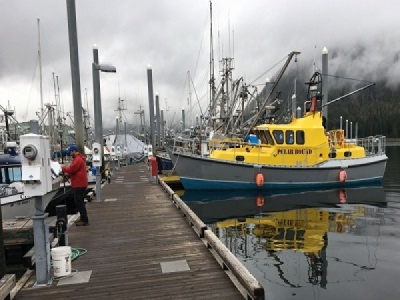
Posted on July 13, 2017
By Michael Izard-Carroll, dvids
The U.S. Army Corps of Engineers, Buffalo District Survey Team conducted project condition surveys (PCS) for the Alaska District in Southeast Alaska from June 5, 2017 through June 16, 2017, covering the Aurora and Harris harbors in Juneau, and the North Harbor in Petersburg.
The Buffalo District Survey Team has provided similar survey services assistance to several other Districts over the last 4 years, including Jacksonville, Galveston, St. Louis, Norfolk, Huntington and Louisville. The Alaska District had a temporary need of experienced surveyors who could conduct “project condition surveys”. A PCS is a periodic assessment of Federal navigation channels and projects, which is used for channel clearance assessment. These condition surveys are primarily used to determine if project conditions (e.g. shoaling) have changed enough to warrant maintenance dredging. Shoaling is the sand, silt, soil and other materials that builds up on the bottom of a body of water over time.
“The PCS is very important because it allows our stakeholders to determine the current condition and clearance of the navigation channels”, said Roman Figler, Chief of the Buffalo District Survey Team. “Knowing how much available clearance there is and the draft a boat has can prevent it from running aground or being damaged.”
Each year, 2.3 billion tons of cargo (foreign and domestic) moves through U.S. ports and waterways, at a value of $2 trillion. Fifty-nine high-use harbor projects account for 90 percent of the cargo moving on the harbors and channels, carrying more than 10 million tons per year.
The survey team uses a multi-beam sonar system, which provides a full-bottom, three-dimensional mapping of the harbor. To capture the project conditions, 256 sonar beams are directed downward to the harbor floor and once the data is collected and analyzed, it is converted to a map using computer-aided drafting software. The team is still in the process of analyzing the data, Figler said.
“We were fortunate to have the Buffalo District come out because our existing workload required us to seek additional resources to assist us,” said Tom Sloan, Chief of the Alaska District Survey Team. “In addition to the team’s technical skills, the Buffalo District team had the talent and the experience to get the job done efficiently.” While conducting the surveys, the Survey Team also trained a new-hire in the Alaska District, who benefited from seeing the work performed, Figler said.
To minimize costs and to keep the survey project within budget, the Buffalo District Survey Team rented a 26-foot long boat and a portable multi-beam sonar system to properly equip the boat for the job. They also had some additional survey equipment shipped to the project site in advance of their arrival. The team consisted of a pair of two-person crews, and a recent hire from the Alaska District.
To maximize efficiency, the two crews worked independently during the high and low tide events. During low tide, the hydro crew surveyed the deep water portion of the federal channel and the land crew surveyed the tidal flats, which also served as the ground truthing for the multi-beam survey. During high tide, the hydro crew surveyed the entire federal channel and the land crew completed a survey to locate all of the docks.
The Buffalo District Survey Team routinely conducts 36 PCS surveys each year as part of its normal workload, along with dredging support surveys. The Buffalo District has been fortunate over the last few years to have had the opportunity to assist other districts during temporary workload capacity shortages.
“The Corps of Engineers Survey Community of Practice is very active and we develop strong working relationships with our counterparts across the Corps”, said Figler. “It gives us the ability to pick up the phone or send an email out to get a question answered or get some additional personnel to meet execution goals.”
“We look forward to opportunities to help out other districts and have found that it is beneficial for both of us. In this case, they got to see how we approached the field execution and had one of their personnel trained with hands on experience,” said Figler. “We are all on the same team, so if we can help out, we will.”
Source: dvids





